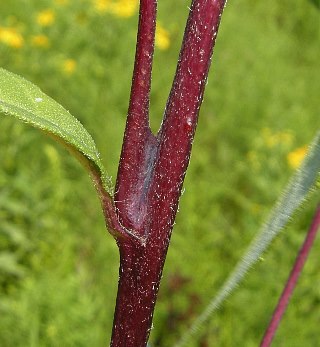Description: This herbaceous perennial wildflower is 3-8' tall and unbranched, except toward the apex where the flowering heads occur. The central stem is terete, light green or dark red (often the latter), and sparsely covered with stiff bristles. The middle to upper leaves are alternate, while the lower leaves are either alternate or opposite; they are up to 7" long and 1¼" across. The leaves are narrowly lanceolate and slightly toothed along their margins; they have short slender petioles up to ½" long. The upper surface of each leaf is rough-textured, while the lower surface is covered with fine short hairs

The upper stems
terminate in several flowerheads. Each flowerhead spans 2–3½" across,
consisting of 10-20 yellow ray florets and numerous yellow disk florets
(typically about 60). The disk florets are fertile, while the ray
florets are sterile. Individual ray florets are oblong in shape and
petal-like, while the tiny disk florets are tubular-shaped with 5
spreading lobes. At the base of each flowerhead, there are several
floral bracts (phyllaries) that are light green, linear in shape, and
ciliate along their margins. They are arranged loosely together. The
blooming period occurs from late summer into the fall and lasts about
1½ months. Each fertilized floret is replaced with an achene about 3-4
mm. long that is oblongoid in shape and somewhat flattened; there are 2
deciduous awns at its apex. The root system is fibrous and rhizomatous.
This sunflower often forms vegetative clumps.
Cultivation:
The preference is full to partial sun, moist conditions, and soil
containing loam, sandy loam, or muck. The size of individual plants
varies according to soil fertility and moisture levels.

Range &
Habitat:
The native Luxuriant Sunflower is found primarily in NE Illinois, where
it is
uncommon (see Distribution
Map). Because this sunflower is a hybrid of Helianthus
giganteus and Helianthus grosseserratus,
it is usually found where the ranges of these two species intersect.
Habitats include sedge meadows, calcareous fens, edges of sandy and
non-sandy marshes, and moist prairies. This sunflower is found
primarily in moist open areas.
Faunal Associations:
The florets are cross-pollinated primarily by bees, including
bumblebees, honeybees, and Andrenid bees. The following Andrenid bees
are specialist pollinators of Helianthus spp.
(Sunflowers): Andrena accepta, Andrena
aliciae, and Andrena helianthi. Other
insect pollinators include butterflies, bee flies, and the larger
Syrphid flies. Many insects are known to feed on various parts of
sunflowers, including aphids, leafhoppers, grasshoppers, leaf beetles,
weevils, plant bugs, larvae of moths, and others. The Insect
Table lists many of these species. Sunflowers are preferred food
plants for the larvae of two butterflies, Chlosyne nycteis
(Silvery Checkerspot) and Chlosyne gorgone (Gorgone
Checkerspot). Among vertebrate
animals, sparrows, goldfinches, and other birds eat the large and
nutritious seeds (see the Bird Table), as do some small rodents
(Thirteen-Lined Ground Squirrel, Meadow Vole, and White-Footed Mouse).
White-Tailed Deer and the Cottontail Rabbit feed on the leaves and
young stalks of sunflowers. Among wetland species, the Muskrat
occasionally feeds on the stalks or uses them in the construction of
its lodges. In general, the ecological value of this and other
sunflowers to wildlife is high.
Photographic Location: A prairie at Meadowbrook Park in Urbana, Illinois, where this species was introduced.

Comments: This sunflower is usually taller than the surrounding vegetation and quite showy. Luxuriant Sunflower is similar in appearance to its parental species, Helianthus giganteus (Giant Sunflower) and Helianthus grosseserratus (Sawtooth Sunflower). This hybrid sunflower and its two parents can be distinguished from each other by examining their respective stems: Giant Sunflower has stems that are abundantly covered with long spreading hairs, while Sawtooth Sunflower has stems that are hairless and often glaucous. The Luxuriant Sunflower is intermediate between these two: its stems are sparsely covered with short bristly hairs. However, some authorities prefer to classify specimens with such stems as variants of the Giant Sunflower. All three of these sunflowers prefer open habitats that are somewhat damp. Such sunflowers rank among the preferred hosts of an uncommon parasitic plant, Cuscuta glomerata (Rope Dodder). Because of its dense mass of flowers, this is one of the more attractive Dodder species.